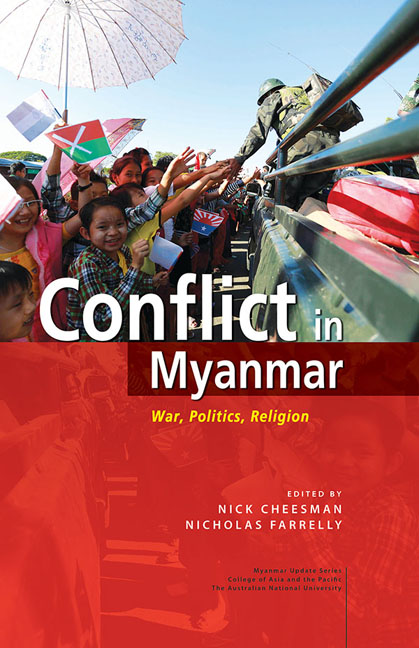Book contents
- Frontmatter
- Contents
- List of Maps
- List of Tables
- List of Figures
- Acknowledgements
- Contributors and Editors
- Part I Introduction
- Part II War and Order
- 2 The politics of policymaking in transitional government: A case study of the ethnic peace process in Myanmar
- 3 Reexamining the centrality of ethnic identity to the Kachin conflict
- 4 A feminist political economy analysis of insecurity and violence in Kachin State
- 5 Pacifying the margins: The Pa-O Self-Administered Zone and the political order in southern Shan State
- 6 Landmines as a form of community protection in eastern Myanmar
- Part III Elections and After
- Part IV Us and Them
- Part V Conclusion
- Abbreviations and Key Terms
- Index
4 - A feminist political economy analysis of insecurity and violence in Kachin State
from Part II - War and Order
Published online by Cambridge University Press: 22 July 2017
- Frontmatter
- Contents
- List of Maps
- List of Tables
- List of Figures
- Acknowledgements
- Contributors and Editors
- Part I Introduction
- Part II War and Order
- 2 The politics of policymaking in transitional government: A case study of the ethnic peace process in Myanmar
- 3 Reexamining the centrality of ethnic identity to the Kachin conflict
- 4 A feminist political economy analysis of insecurity and violence in Kachin State
- 5 Pacifying the margins: The Pa-O Self-Administered Zone and the political order in southern Shan State
- 6 Landmines as a form of community protection in eastern Myanmar
- Part III Elections and After
- Part IV Us and Them
- Part V Conclusion
- Abbreviations and Key Terms
- Index
Summary
The drama and tragedy that began to unfold in June 2011 after a military attack on Kachin army outposts in the north of Myanmar is usually explained in terms relating to military conflict, power struggles, and the failure of the Myanmar state to include and respect the rights of minority groups (International Crisis Group 2013; Lintner 1990; Smith 2007). The relationship between gender and conflict rarely enters the discussion, unless (Kachin) women are portrayed as victims of (state) violence. Women's experiences of and responses to the conflict that do not fit with the dominant image of woman-as-victim are then typically silenced.
This chapter challenges that dominant narrative by critically investigating women's conception of and involvement in the Kachin Independence Army (KIA). It provides a new lens to understand the conflict between the Myanmar state and the Kachin minority group by exploring the circumstances that lead women to join or support the armed struggle in Kachin State, asking why and how women are involved in the conflict. Using theoretical insights provided by feminist political economy, it analyses the material basis for women's support for and involvement in the KIO/KIA.
Recent research (Henshaw 2015; Mazurana 2013; Shekhawat 2015) suggests that women — like men — join armies for ideological and political reasons related to their position as members of a marginalized ethnic and religious group. However, a more careful gender analysis will reveal that women's decisions to participate in or support armed struggle stem from gender-specific experiences of insecurity and oppression. In Kachin State, these gender differences are visible in the high number of female-headed households compared to other areas of Myanmar (Union of Myanmar 2015b); the inability of women to inherit property (KWAT 2014, p. 26); and the deliberate targeting of minority women by Myanmar armed forces, or Tatmadaw, officers and soldiers (Human Rights Watch 2012).
It is important to note that women's exposure to gender-based violence in Myanmar is related to their exclusion from positions of power and influence. This exclusion reflects a gendered division of labour that holds men as the representatives of the collective, as evidenced by the acute lack of women in leadership positions within both the local and the national polity (Minoletti 2014).
- Type
- Chapter
- Information
- Conflict in MyanmarWar, Politics, Religion, pp. 67 - 90Publisher: ISEAS–Yusof Ishak InstitutePrint publication year: 2016

